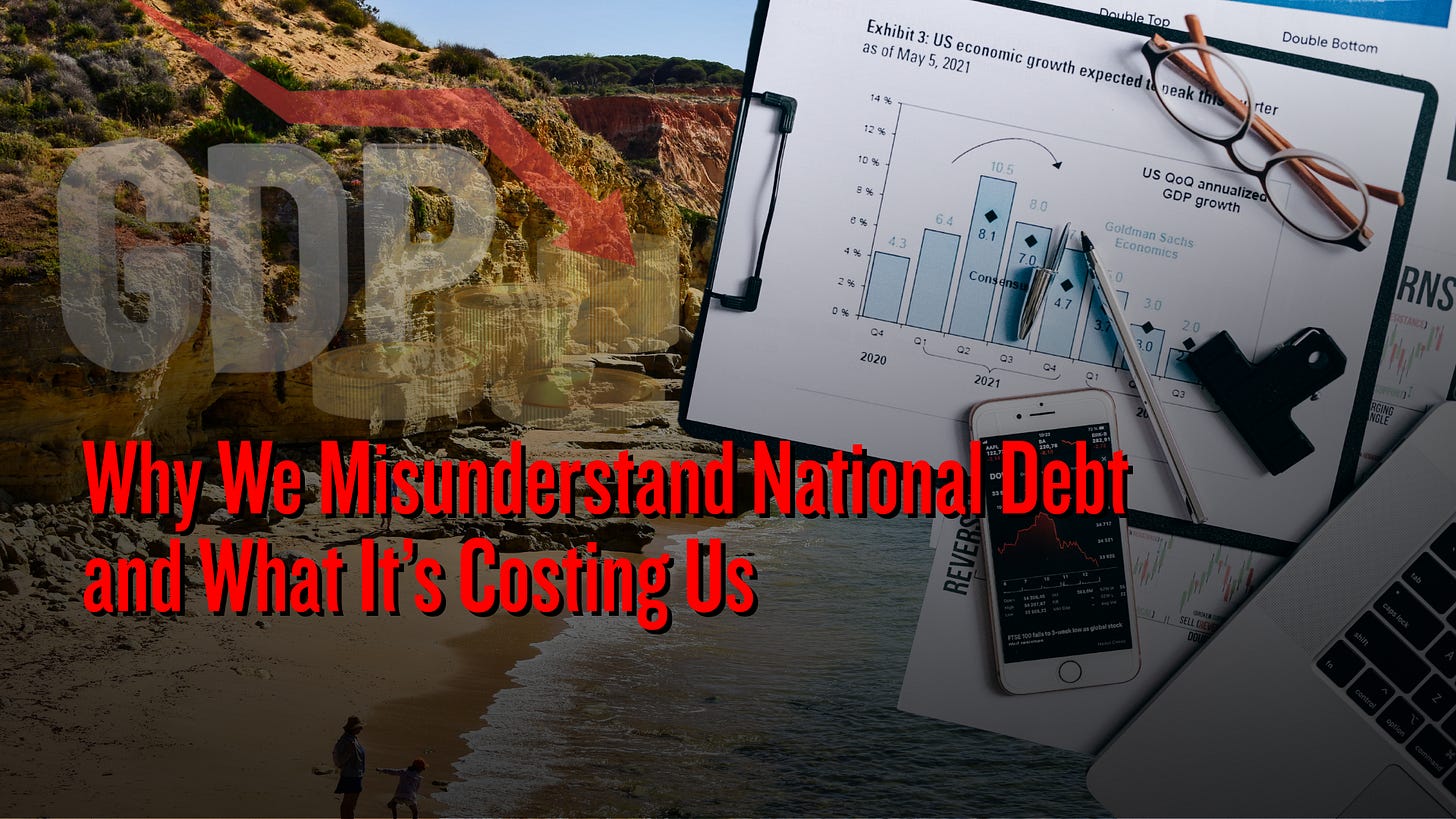The Great Debt Fallacy: Why We Misunderstand National Debt and What It’s Costing Us
Guest article by Tulsi Tawari
The word “debt” evokes a visceral reaction—burden, repayment, insolvency. For individuals and corporations, this framework makes sense. But when applied to national economies, the analogy breaks down. Yet, our media, economists, and policymakers remain trapped in this flawed comparison, leading to public confusion and, worse, policies that compromise national prosperity.
It’s time to confront the fallacy of national debt—especially in the context of major economies like the United States and Japan—rising beyond their GDPs. The prevailing fearmongering around national debt not only ignores the unique nature of sovereign fiscal systems but also diverts attention from the real crisis: the erosion of prosperity and economic dignity for the middle class.
A Nation Is Not a Household
The first and most fundamental error is treating national debt as if it were equivalent to household or corporate debt. Here’s why that analogy is fatally flawed:
Nations Don’t Die
People pass away. Companies go bankrupt. Nations, on the other hand, are perpetual constructs—composed of generations of citizens, with self-renewing political and economic institutions. The “end date” logic of personal or corporate finance simply doesn’t apply.National Debt Is Largely Self-Owned
In most developed nations, the majority of national debt is owed internally—to domestic institutions, citizens, or even government branches like the Federal Reserve. For the U.S., foreign ownership of the debt is under 20%. This means the debt is more akin to a reallocation of internal capital, not a ticking time bomb owed to some external entity.
The Real Metric: Prosperity, Not Repayment
Economists often obsess over future repayment scenarios. But that obsession masks the far more important issue: What is the debt actually doing to the prosperity of a nation’s people?
Take the U.S. as a case in point. Since the 1970s, average Americans have seen a staggering decline in their share of national prosperity. In real terms, wealth and income gains have concentrated at the top, while the median worker’s ability to afford basic needs—housing, healthcare, education—has diminished. Middle-class families now require dual incomes and gig work simply to survive.
This isn't a story of irresponsible borrowing. It's a story of misallocated capital and the failure to convert national spending into shared, durable wealth.
The Great Fallacy of “Repayment”
Here lies the most dangerous myth in modern economics: that future taxpayers must eventually repay all national debt. This belief ignores the true first principle of sovereign economics—that productive deficit spending, which creates real GDP and prosperity, doesn’t need to be “paid back.” It's already paid for—by the resulting wealth creation.
This misunderstanding causes governments to hesitate in moments when aggressive, transformative investments are needed most: in science, infrastructure, green energy, and next-generation education.
Three Principles to Rethink Debt—and Rebuild Prosperity
If we are to reclaim the economic dignity of citizens and realign national policy with the realities of modern sovereign finance, we must embrace three guiding principles:
1. Link Debt Forgiveness to Fresh GDP Creation
National debt should be seen as a ledger of investments, not a static burden. To the extent that a country’s GDP grows from deficit-funded activity, equivalent portions of debt should be amortized or written off in economic terms. It’s not creative accounting; it’s reflective accounting.
For example, if $1 trillion in national debt led to $1 trillion in new productive capacity, innovation, or infrastructure that continues to yield returns—then the economic system has already paid for that investment.
2. Reduce Foreign Holdings of National Debt
Debt held by foreign nations does pose risks—not because of economics, but geopolitics. When a nation’s obligations are largely internal, it retains full monetary sovereignty. But when external entities hold significant portions of its debt, it cedes leverage and, to some extent, policy freedom. A reorientation of national debt portfolios toward internal ownership is a move toward stronger democratic sovereignty.
3. Invest in Exponential Wealth Creation
The golden age of American prosperity—from 1945 to the early 1970s—was not a fluke. It was the result of deliberate national investment in technological leadership, education, infrastructure, and cultural ambition. The true fix for debt isn’t austerity—it’s innovation.
Debt used to finance exponential innovation, like the space race or the digital revolution, returns multifold in GDP growth, tax revenue, and national wellbeing. The solution lies in wealth generation, not arbitrary repayment.
Too often, media headlines sensationalize debt levels crossing GDP ratios without context. What we need instead is a new economic literacy—one that distinguishes between types of debt, prioritizes prosperity over panic, and measures the health of an economy by the living standards of its people, not by an abstract ratio.
Nations are not credit card holders. They are stewards of intergenerational prosperity. It’s time we stop managing them like consumers—and start leading them like architects of the future.


It's a new line of thought. But the question remains why a creditor (inboth internal and external public debt) should pay you money if it doesn't come back. No amount of growth can compensate the creditor's loss of money. If there is negative growth how are we going to repay the creditor.
A very nice analysis. Nations like India should not shy from external borrowing as prudent leadership prevails here.